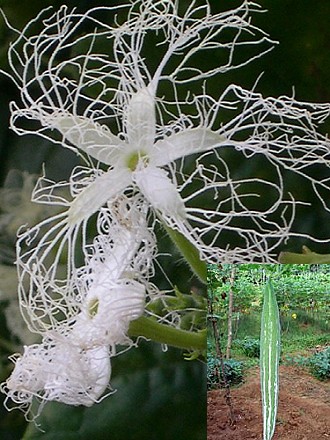
|
|
Snake gourd (Trichosanthes cucumerina)
flower and fruit
|
Snake gourd - Trichosanthes cucumerina
An unusual Asian gourd is the snake gourd (Trichosanthes cucumerina). This species is grown
as ornamental and for food in tropical Asia, but become quite bitter with age. Like its common name implies, the snake or serpent gourd in very long and slender, reaching 6 feet (2 m) in length. The showy, fragrant, white flowers have striking corolla lobes fringed with long hairs.
The Gourd Family comprises about 90 genera and some 700
species, mostly coarse climbing annual and perennial herbs of tropical and subtropical regions around the
world, extending even into the temperate zones. The genus Trichosanthes comprises about 100 species, native to southern and eastern Asia, Australia and islands of the western Pacific. Trichosanthes cucumerina is found wild throughout these areas. It was probably domesticated in ancient times in India, from where non -bitter and large-fruited types may have migrated to other tropical areas. It is grown as a minor vegetable in many countries of tropical Asia. It is locally grown as a vegetable in home gardens in Africa, where it has been recorded from several countries and probably occurs in many more. Commercial growers around big cities in East Africa occasionally grow cultivars of snake gourd imported from India for people of Indian origin.
Two varieties are distinguished within Trichosanthes cucumerina: the wild var. cucumerina occurring from India, Sri Lanka and China, through South-East Asia, to northern Australia, and the cultivated var. anguina (L.) Haines with its elongated fruits. Only traditional landraces of Trichosanthes cucumerina are used in West and Central Africa, whereas improved cultivars from India are grown in East Africa.
Flowering starts 5–6 weeks after emergence of the seedling. Male flowers appear first followed by female ones 3 days later. The flowers open in the evening or in the early morning. Anthers dehisce several hours before anthesis, stigmas are receptive from a few hours before anthesis to a few hours after. Pollination is effected by insects, including bees, wasps, ants, butterflies and moths. The showy, fragrant, white flowers have striking corolla lobes fringed with long hairs.
They are fragrant only at night
The narrow, soft-skinned fruit can reach
200 cm long. Its soft, bland, somewhat mucilaginous flesh is similar to that of the luffa and the calabash.
Young fruit is edible. It can be used in curries or eaten as a vegetable like green beans. The bright red pulp around the mature seeds is extracted and used in cooking in much the same way that tomatoes are
used. It is most popular in the cuisine of South Asia and Southeast Asia. The shoots, tendrils, and leaves are also eaten as greens.
Trichosanthes cucumerina is used also for medicine.
The fruit is considered to be anthelmintic, emetic and purgative. An infusion of the young shoot is mildly aperient, the leaf sap is emetic.
The seed is said to be cooling. Peptides in the plant are used as an abortifacient in China.
Source:
http://database.prota.org/PROTAhtml/Trichosanthes%20cucumerina_En.htm
http://en.wikipedia.org/wiki/Snake_gourd
http://www.pfaf.org/database/plants.php?Trichosanthes+cucumerina+anguina
http://waynesword.palomar.edu/ww0503.htm
